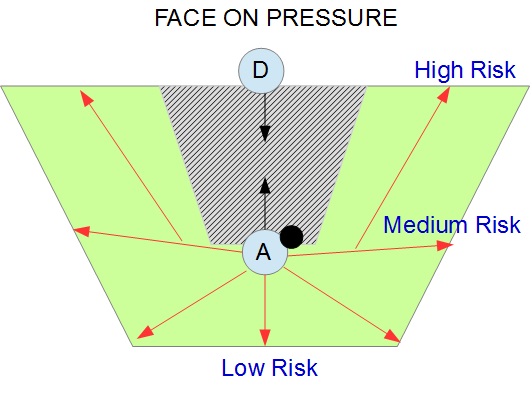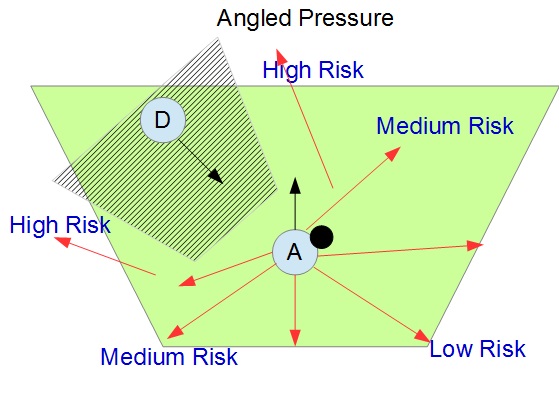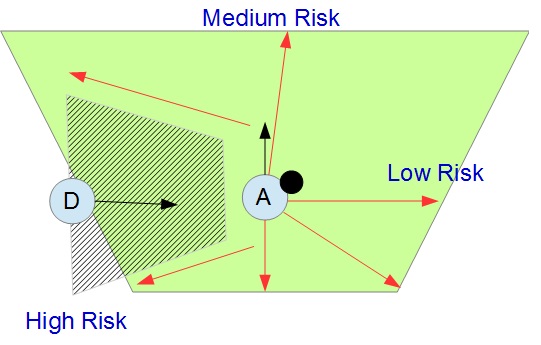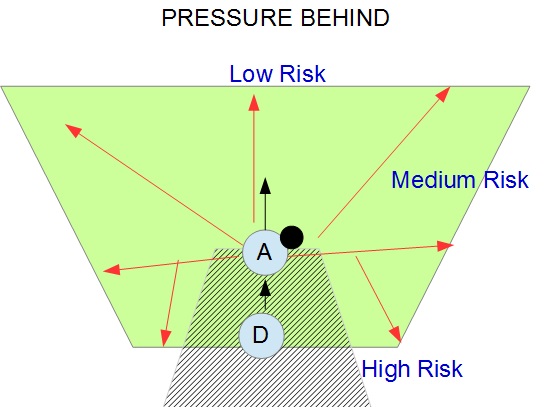P2: Pressure Problems
Pressure Problems
Page 2
When developing a footwork system it makes sense to start with the essence of the game ;
Solving problems.
To help this process consider what we call :
Pressure Problems
Pressure Problems are at the heart of the game at an individual level.
Whenever a player is on the ball (or about to receive it), one of the first things they need to be aware of is 'Where is the pressure coming from'? (Space and passing options are the 2 other key things - but if you know where the pressure is, then everywhere else must be an option).
It is very important that Pressure Problems are understood as this helps explain why the Fundamental Footwork Patterns are so important to not only know about, but also to embed deeply in the sub-conscious.
What are basic Pressure Problems?
Description and explanation of the basic Pressure problems below
Pressure Problem
Expressed as a Picture
Video
Face - On Pressure Problems
Face - On Pressure
In simple terms this is : The defender (pressure) and the attacker (player with the ball) are facing each other.
In the picture the black arrows show the direction players are facing. The red arrows show you where the attacker can take the ball.
If you assume the attacker ideally wants to get past the defender then this becomes a risk reward equation. Good players (Messi/Iniesat/Neymar) successfully go for the high risk high reward option and add huge value to a moment. Safe players may always go for the low risk option. (Just think of a player who always plays backwards). They don't loose possession but dont always add value to a moment - and that's ok as long as it is the right thing to do. Paul Scholes is quoted as saying he retired because he had lost the ability to play bravely and take risks.

Finally the high risk options never change in a pressure moment, but the reward is always dependent on what the players wants to achieve. So the high risk option might not always be accompanied with high reward. This where player intelligence comes in. Can players recognize where the high reward option is, and thereafter make a decision about whether it is worth the risk to get there.
Face - On Pressure
Angled Pressure Problems
Angled Pressure
In simple terms this is : The defender (pressure) is approaching the attacker (player with the ball) to an angle, relative to the direction the attacker is facing.

Angled Pressure
Side - On Pressure Problems
Side On pressure
In simple terms this is : The defender is approaching the attacker from the side, relative to the direction the attacker is facing.

Side On pressure
Along-Side Pressure Problems
Along Side pressure
In simple terms this is : The defender is running along side the attacker, relative to the direction the attacker is facing.

Along Side pressure
Pressure Behind Pressure Problems
Pressure Behind
In simple terms this is : The defender is approaching the attacker from behind, relative to the direction the attacker is facing.

Pressure Behind
These are the simplest depictions of pressure problems.
There are few more variations but they will be looked at later.
From this you can see that a player must be very good at moving the ball around their feet. A player can go anywhere except through the defender. We ignore nutmegs as an option. And these problems will mean that players will sometimes:
- move the ball back towards their body
- move the ball across their body
- move the ball out of the body to space
- move the ball to beat a player (to a space or to get in behind)
- turn
- protect the ball
- use a little bit of deception.
- use the inside, the outside or the bottom of the feet or a combination of these
- take 1 step between touches, other times it will be none, and other times it will be 2 or more
With so many variables the obvious question is how do you get a footwork system out of all the above?
When a developing foot work system, you'd want something that allows a player to achieve all of the above efficiently and effectively, without being too simplistic (which creates the need for too much reinvention and improvisation) or too complicated (which takes too long to perfect and learn how to apply).
For every pressure problem moment in a game, you'd need a footwork pattern that quickly solves the problem faced. If each solution required a different footwork pattern, then this would be too much to learn and practice. There would simply be too much to cover. Most team coaches look at footwork a little like this and so don't teach footowork or over simplify it, or others send players off in the wrong direction by making footwork all about 1v1 'tricks' that are meant to help players beat an opponent and supposedly stimulate creativity.
But what if all a player needed was to develop 'about' 15 Footwork Patterns and these patterns (on its own, combined with other patterns or improvised ) were all that was needed to solve all basic pressure problems.
What if these patterns are developed to such a level that when pressure comes from one direction and the ball is in a particular position (say position A), the brain just thinks 'get the ball form A to B' without having to think about how this gets done. The subconscious simply chooses the pattern (which you know is efficient and effective because that's all your brain knows and you practice) will do the job.
It is these 15 patterns which are at the heart of TST, and they are called the
Fundamental Footwork Patterns
By using the FFPs, the process of developing good footwork in conjunction with solving problems (at an individual level) becomes achievable by all players - not just the highly gifted ones.
Most Australians, even the ones in the National team, do not acquired it naturally. In 2018 Mooy was maybe the only exception. He has very good fundamentals and you can tell by how he is on the ball. Rogic also has great technique, but it is clear he has trod a different path on the technical development journey and has done a very good job of it. However, players who came late to the national level (Leckie/Nabbout) have got there more for their physical attributes than as a result of highly developed technique. Imagine how good they would have been with an efficient and effective footwork system in combination to their physical advantages.
So bringing this back to youth football. You may think a particular child is a good player, but i guarantee their is huge room for improvement, no matter how good he or she appears right now. There will huge areas for improvement in regards to developing highly advanced neural pathways.
Or you may think a player lacks the natural talent to become a really good player, but this is simply not true. 'Hard work beats talent when talents doesn't work hard'.
Technique is one of the most controllable and manageable components of development and in reality there no reason (other than a lack of appropriate input and practice) for any older player (who has gone through the development phase) to not be technically strong.
****
The next page in this 'Fundamental Footwork Pattern (FFP) mini web-book' will look at pressure problems in more detail and start to link FFPs and Pressure problems together and show why the FFPs are a critical building block in the development of a good player.